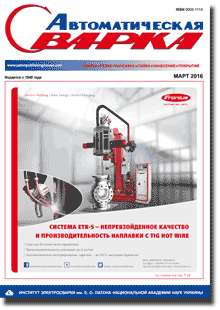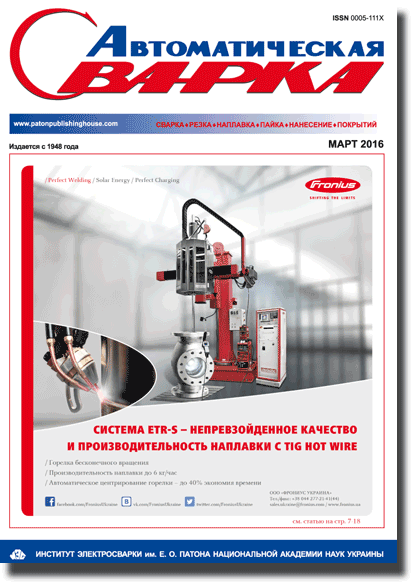| 2016 №03 (08) |
DOI of Article 10.15407/as2016.03.01 |
2016 №03 (02) |

Avtomaticheskaya Svarka (Automatic Welding), #3, 2016, pp. 7-18
Advanced gas tungsten arc welding (surfacing) current status and application
S. Egerland, J. Zimmer, R. Brunmaier, R. Nussbaumer, G. Posch And B. Rutzinger
Fronius International GmbH, Wels, Austria. E-mail: egerland.stephan@fronius.com
Abstract
Gas Shielded Tungsten Arc Welding (GTAW) — a process well-known providing highest quality weld results joined though by lower performance. Gas metal arc welding is frequently chosen to increase productivity along with broadly accepted quality. Those industry segments, especially required to produce high quality corrosion-resistant surfacing, e.g. applying nickel-based filler materials, are regularly in consistent demand to comply with «zero defect» criteria. In this conjunction weld performance limitations are overcome employing advanced «hot-wire» GTAW systems. This paper, from a welding automation perspective, describes the technology of such devices and deals with the current status is this field, namely the application of dual-cathode hot-wire electrode GTAW cladding, considerably broadening achievable limits. 27 Ref., 2 Tables, 14 Figures.
Keywords: GTAW (cladding), single-cathode GTAW, hot-wire welding, dual-cathode GTAW
Received: 15.01.16
Published: 28.04.16
References
- Egerland, (2010) Controlled GMA welding processes prove applicability for high-quality weld overlay. In: Welding and Repair Technology for Power Plants: Proc. of 9th Int. EPRI Conf. (2010 June 23–25, Fort Myers). Palo Alto: Electric Power Research Institute.
- Egerland, (2009) Status and perspectives in overlaying under particular consideration of sophisticated welding processes. Quart. J. JWS, 27(2), 50–54. https://doi.org/10.2207/qjjws.27.50s
- Egerland, S., Helmholdt, R. (2008) Overlaying (cladding) of high temperature affected components by using the cold metal transfer process. In: Safety and reliability of welded components in energy and proc. industry, 327–332. Graz: Verlag der Technischen Universitat.
- Freeman, N.D., Manz, A.F., Saenger, J.F.Jr. Inventors; Union Carbide Corp, Method for depositing metal with a TIG arc. Pat. US 3483354. Publ. Dec. 9, 1969.
- Manz, F., Norman, R., Wroth, R.S. Inventors; Union Carbide Corp, assign. Electric arc working with hot wire addition. Pat. US 3163743. Publ. Dec. 29, 1964.
- Manz, A.F. Inventors; Union Carbide Corp, assign. Consumable electrode arcless electric working. Pat. US 3122629A. Publ. Feb. 25, 1964.
- Mizuno, T., Shimizu, T. Inventors; Kaisha MDK assign. Hot wire welding system. US 4464558A. Publ. Aug. 7, 1984.
- Goldsberry, C. (2007) Hot-wire TIG: Not new but gaining appeal. http://weldingdesign.com/ archive/hot-wire-tig-not-new-gaining-appeal
- Manabe, Y., Wada, H., Zenitani, S. (2000) Investigation on TIG welding using 2 filler wires with electromagnetically controlled molten pool process in horizontal position. J. JWS, 8(1), 40–50; https://doi.org/10.2207/qjjws.18.40
- Hori, K., Watanabe, H., Myoga, T. et al. (2004) Development of hot wire TIG welding methods using pulsed current to heat filler wire: Research on pulse heated hot wire TIG welding Welding Int., 18(6), 456–468; https://doi.org/10.1533/wint.2004.3281
- Ueguri, S., Tabata, Y., Shimizu, T. et al. (1986) A study on control of deposition rate in hot-wire TIG welding. Quart. JWS, 4(4), 678–684; https://doi.org/10.2207/qjjws.4.678
- Yamamoto, M., Shinozaki, K., Myoga, T. et al. (2008) Development of ultra-high-speed GTA welding process using pulse-heated hot-wire. In: Pre-Prints of the 82nd Nat. Meeting of JWS, 228–229.
- Shinozaki, K., Yamamoto, M., Nagamitsu, Y. et (2009) Melting phenomenon during ultra-high-speed GTA welding method using pulse-heated hot-wire. Quart. J. JWS, 27(2), 22–26; https://doi.org/10.2207/qjjws.27.22s
- Adonyi, Y., Richardson, R., Baeslack, W. (1992) Investigation of arc force effects in subsurface GTA welding. Welding J., 71(9), 321–330.
- Rokhlin, S., Guu, A. (1993) A study of arc force, pool depression, and weld penetration during gas tungsten arc welding. Ibid., 72(8), 381–390.
- Mendez, P., Eagar, T. (2003) Penetration and defect formation in high-current arc welding. Ibid., 82(10), 296–306. https://doi.org/10.2172/835707
- Yamada, M. (1998) Development of high efficiency TIG welding met 1st Rep. of JWS, 63, 24–25.
- Yamada, M., Tejima, A. Inventors; Ishikawajima-Harima Heavy Industries Co. assign. TIG welding apparatus and method. Pat. US 6982397. Publ. Jan. 3, 2006.
- Kobayashi, Nishimura, Y., Iijima, T. et al. (2013) Practical application of high efficiency twin-arc TIG welding method (SEDAR-TIG) for PCLNG storage tank. Welding in the World, 48(7/8), 35–39.
- Norrish, J. (2006) Advanced welding processes. Cambridge: Woodhead Publ. https://doi.org/10.1533/9781845691707
- Zhang, , Leng, X., Lin, W. (2006) Physics characteristic of coupling arc of twin-tungsten TIG welding. Transact. of Nonferrous Metals Soc. of China, 16(4), 813–817. https://doi.org/10.1016/S1003-6326(06)60331-2
- Leng, X., Zhang, G., Wu, (2006) The characteristic of twin-electrode TIG coupling arc pressure. J. Phys. D: Appl. Phys., 39(6), 1120–1126; https://doi.org/10.1088/0022-3727/39/6/017
- Maecker, H. (1955) Plasmastromungen in Lichtbogen infolge eigenmagnetischer Kompression. Zeitschrift fur Physik, 141(1), 198–216. https://doi.org/10.1007/BF01327300
- Zhang, G., Xiong, J., Gao, H. et al. (2012) Effect of process parameters on temperature distribution in twin-electrode TIG coupling arc. Quantitative Spectroscopy & Radiative Transfer, 113(15), 1938–1945; https://doi.org/10.1016/j.jqsrt.2012.05.018
- Martins, E. (2010) Avaliacao da soldagem tig autogena duplo catodo twin Tig [trabalho de graduacao]. Florianopolis: Universidade Federal de Santa Catarina.
The cost of subscription/purchase order journals or individual articles
| Journal/Currency | Annual Set | 1 issue printed |
1 issue |
one article |
| TPWJ/USD | 384 $ | 32 $ | 26 $ | 13 $ |
| TPWJ/EUR | 348 € | 29 € | 24 € | 12 € |
| TPWJ/UAH | 7200 UAH | 600 UAH | 600 UAH | 280 UAH |
| AS/UAH | 1800 UAH | 300 UAH | 300 UAH | 150 UAH |
| AS/USD | 192 $ | 32 $ | 26 $ | 13 $ |
| AS/EUR | 180 € | 30 € | 25 € | 12 € |
| SEM/UAH | 1200 UAH | 300 UAH | 300 UAH | 150 UAH |
| SEM/USD | 128 $ | 32 $ | 26 $ | 13 $ |
| SEM/EUR | 120 € | 30 € | 25 € | 12 € |
| TDNK/UAH | 1200 UAH | 300 UAH | 300 UAH | 150 UAH |
| TDNK/USD | 128 $ | 32 $ | 26 $ | 13 $ |
| TDNK/EUR | 120 € | 30 € | 25 € | 15 € |
AS = «Automatic Welding» - 6 issues per year;
TPWJ = «PATON WELDING JOURNAL» - 12 issues per year;
SEM = «Electrometallurgy Today» - 4 issues per year;
TDNK = «Technical Diagnostics and Non-Destructive Testing» - 4 issues per year.





